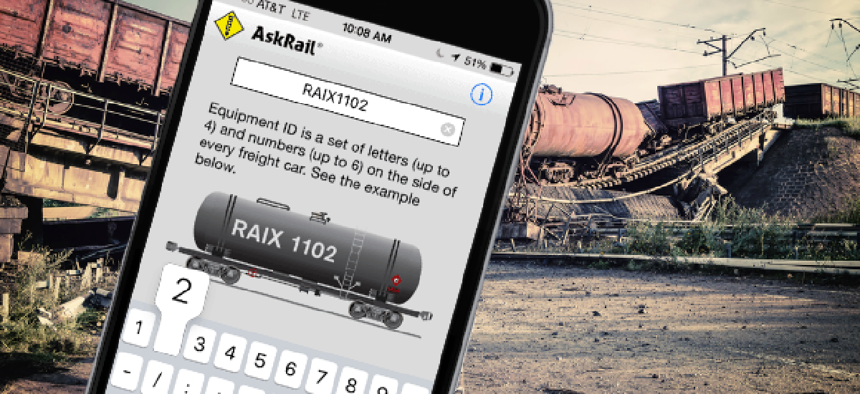Full service app for railroad emergency response

AskRail app gives responders to a railroad incident details about the cars and their contents as well as resources on handling hazardous materials and maps of nearby facilities.
When a train accident in Charlottesville, Va., almost 40 years ago resulted in a dangerous fire, it took firefighters some 12 hours to figure out whether the railcars were carrying hazardous materials. Today, they would know in minutes using AskRail.
Launched in 2014, AskRail is a mobile app developed by the International Association of Fire Chiefs and the Association of American Railroads (AAR) that’s available for free to first responders who need to know what to expect at the scene of a train incident. Users enter railcar numbers into the app’s search engine to instantly see what’s onboard. They can also check what’s on the entire train, get guidance on handling hazardous substances and call emergency contacts for various railroads.
“Before I would have had to look at all different resources,” said Charles Werner, a 37-year veteran of the Charlottesville Fire Department who now serves on the boards of the International Association of Fire Chiefs Technology Council, AAR’s Public Safety Advisory Committee and the National Alliance for Public Safety GIS Foundation. “We’re able now to get a good idea of what’s on the train and what’s on the individual cars without really having to be in visual line of sight. We can already get some kind of idea of what the train consists of before we take any action. That’s a huge difference from where we used to be.”
That means fire chiefs and other public-safety personnel can start planning their response before they’re even on the scene, saving time and keeping responders safer, he added.
Railinc, the IT and services subsidiary of AAR, built the app and a data pipeline to automatically get information on train consists -- lists of all the railcars and their contents -- from Class I railroads. When users open the app, they type in a railcar number, the app pings the database and details about the type of car and its contents pop up.
“Whenever the consist changes on the railroad side, they will send that via a message to us, and that becomes part of our data store,” said Joan Smemoe, director of application engineering and software development at Railinc. “Sometimes if they don’t do that, then during the incident, we will make a web service call to pull the latest information.”
The app also integrates with the Emergency Response Guidebook, enabling users to click through for information on handling chemicals, and they can use the map feature to not only pinpoint the incident scene, but also visualize nearby points of interest, including those that could help, such as hospitals, and those that might need to be evacuated, such as schools.
AskRail is available by invitation only. First responders can request access via AskRail.us, but they must be sponsored by a Class I railroad, which has its own approval policies and procedures.
After access is granted, it’s device-based, so no login is required. But Railinc manages security by limiting use of the app to three devices, tracking usage daily and requiring an annual recertification process, he added.
AskRail began in 2014 with railcar lookup that gave first responders a way to get information on railcars should the conductor or physical consist be unavailable at the scene of an incident. Initially, Railinc relied on java stacks for the web application, Android stacks for the Android app and iOS stacks for Apple users. This year, the company used Ionic, a front-end software development kit that’s part of Apache Cordova, to move to a single codebase.
“You develop once in a Java framework and you have to do some additional work, but you’re able to deploy using the Apple and Android and PC framework, so now we have one consolidated codebase and we can respond to the needs from the fire chief and from the railroad incidents response team a lot quicker,” Smemoe said.
Today about 20,000 users across all 50 states and eight Canadian provinces use AskRail.
The app meets everything Werner wished he’d had when he was on the force. Now, he’s part of the conversation to keep AskRail moving forward. Part of that conversation includes looking to the First Responder Network Authority to help ensure connectivity.
“That’s going to enhance that coverage,” Werner said. “Hopefully there will be some satellite coverage at some point that helps to fill in some of those gaps.”
In 2018, Railinc plans to add plume modeling to the app -- something Werner and others recommend. If there’s a chlorine spill that produces a harmful cloud, for example, analytics could calculate wind speed to indicate what areas might be affected.
“What’s most impressive to me is that [Railinc is] constantly is having conversations with and learning from those of us that are responders as to what it is we need, Werner said. “And they’re making that work.”
Editor's note: This article was changed Dec. 22 to clarify the relationship between Railinc and AAR.





